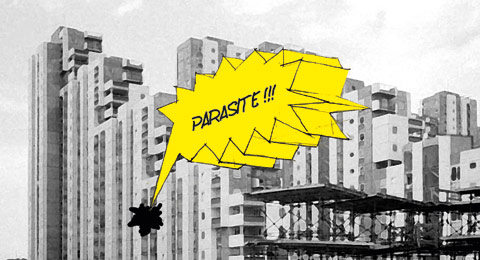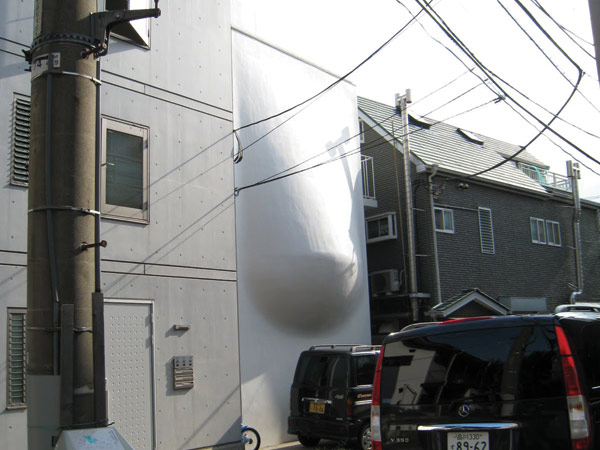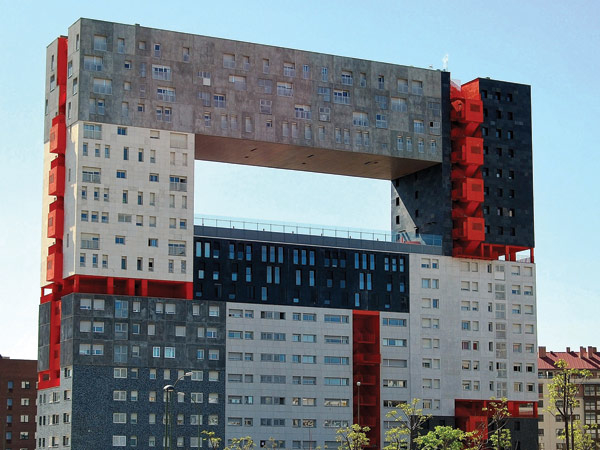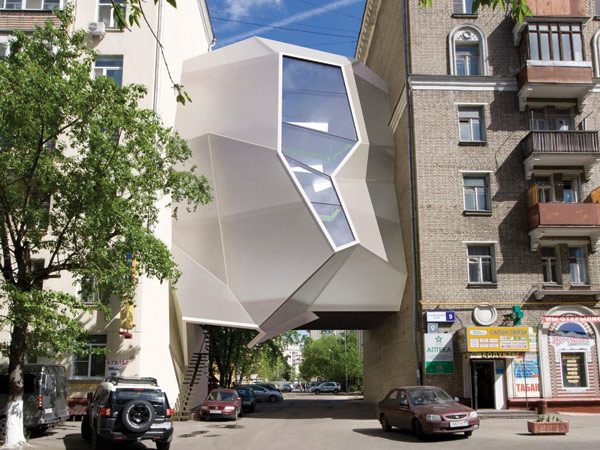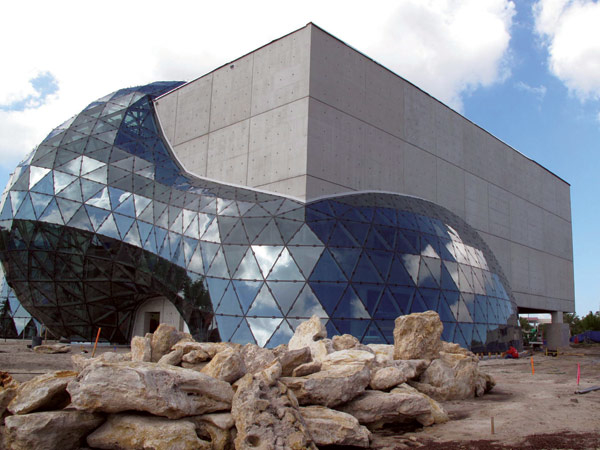PARAZITSKA ARHITEKTURA
Tekst: Marko Stojčić
Živimo u vremenu u kom je neophodno promeniti tradicionalna shvatanja o korišćenju građevinskog prostora. Šta kada unutar grada tog prostora više nema, kada grad prestane da ide u širinu ili visinu? Kao i svaki drugi organizam koji se razvija grad traži najbolje, često i najednostavnije, načine za svoj razvoj. Taj razvoj uglavnom podrazumeva podmlađivanje osnovnih delova organizma, nekada i potpunu promenu sastavnih delova. U opštem razvoju grada arhitektura je primarna disciplina, i kao takva za sobom ostavlja različite objekte i tvorevine. Postavlja se pitanje kako proceniti u rasponu od 70-100 godina koji objekat treba zadržati i rekonstruisati a koji srušiti? Kako se tu uklapa pojam energetske efikasnosti starih objekata ali i promena navika korisnika objekata? Možda je ipak sada pravi trenutak za nastanak novog pravca u arhitekturi, zrelijeg pristupa savremenoj arhitekturi koja ne podrazumeva nužno rušenje starih objekata koji su tehnički još uvek u dobrom stanju i čija funkcija uz manje modifikacije može ispuniti kriterijume sadašnjeg vremena. Novi pravac porazumeva novi život starog objekta, i to ne u vidu puke renovacije već novog života i u umetničkom i u tehničko-funkcionalnom smislu.
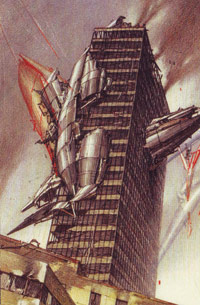 Arhitektura koja nastaje kao potpuno nova koristeći neki od resursa starog objekta se danas najčešće naziva „parazitska arhitektura“. Taj naziv je verovatno previše grub, i to iz prostog razloga što je za nastanak jednog takvog objekta neophodna neka vrsta „saglasnosti“ matičnog objekta pa je time i parazitski status neopravdan. Matični objekat tu vrši veoma važnu ulogu time što snaga novog arhitektonskog izraza zavisi od potencijala i energije koju matica ima u trenutku sjedinjavanja. Interesantan odnos između ova dva se vidi kada i matica i parazit potpuno gube smisao ako bi svoju egzistenciju u prostoru nastavili pojedinačno. Veoma je interesantna pozicija arhitekte koji sada ima zadatak da na potpuno novi način razume i prihvati potrebe i osobenosti „lokacije“ na kojoj gradi.
Arhitektura koja nastaje kao potpuno nova koristeći neki od resursa starog objekta se danas najčešće naziva „parazitska arhitektura“. Taj naziv je verovatno previše grub, i to iz prostog razloga što je za nastanak jednog takvog objekta neophodna neka vrsta „saglasnosti“ matičnog objekta pa je time i parazitski status neopravdan. Matični objekat tu vrši veoma važnu ulogu time što snaga novog arhitektonskog izraza zavisi od potencijala i energije koju matica ima u trenutku sjedinjavanja. Interesantan odnos između ova dva se vidi kada i matica i parazit potpuno gube smisao ako bi svoju egzistenciju u prostoru nastavili pojedinačno. Veoma je interesantna pozicija arhitekte koji sada ima zadatak da na potpuno novi način razume i prihvati potrebe i osobenosti „lokacije“ na kojoj gradi.
U mnogim Evropskim zemljama postoje podsticaji za rekonstrukciju starih objekata. „Reciklaža“ urbanog prostora je tamo poželjnija od izgradnje potpuno novih objekata na praznom prostoru. Neke od arhitektonski naprednih kultura zrelije pristupaju problemu i znatno ranije prihvataju napredne trendove koji svojim razvojem daju kvalitetna rešenja. Postoji više slučajeva u Holandiji, naročito u Roterdamu, gde se do rešenja došlo realizacijom „parazitskih“ objekata. Jedan od najinteresantnijih primera je i objekat „Las Palmas“.
U Beogradu potez od Kalimegdana uz reku Savu pa do glavne autobuske stanice i starog Savskog mosta je urbano tkivo koje vapi za nekom takvom arhitekturom. To je područje koje sadrži neke od najinteresantnijih primera srpske arhitekture iz XIX veka, i kao takvo se nameće da bude rekonstruisano na neki novi, ingeniozniji način, a ne samo restaurirano i vraćeno u prvobitno stanje neprimereno savremenom vremenu. Urbani prostor oko Karađorđeve ulice ima kulturni potencijal koji prevazilazi značaj puke reparacije istorijskog dela grada. Ovaj prostor je delom u prethodnih pet godina počeo da živi neki novi, interesantniji život, ali on ne može biti dugoročno opravdan. On se trenutno oslanja na korišćenje zatečenih objekata sa minimalnim intervencijama, bez značajnih arhitektonskih poteza. Najbliži primer sličnom korišćenju starih objekata je arhitektura u Havani na Kubi, a to jednostavno neodrživo.
Kao veoma interesantan primer nove arhitekture koja se umeće u već definisani urbani ambijent je i minijaturna arhitektura u Tokiju, gde se u punoj meri vidi šta znači nedostatak prostora ali i nesvakidašnje dobar odnos između zatečenog objekta i objekta koji je tek nastao. Dovitljivost arhitekata u ovom slučaju dolazi do punog izražaja. U takvom okruženju mora se isprojektovati objekat bez nekih elemenata svojstvenih modernom vremenu koji zahtevaju prostor, a sa druge strane mora se opravdati, ne tako retko, visoka cena objekta po kvadratnom metru. Rezultat je nova arhitektura, održiva i primerena vremenu u kom živimo.
PARASITE ARCHITECTURE
Text: Marko Stojčić
We live in a time when our traditional views about the usage of building space needs to be re-examined. What happens when all the available space for new constructions in the city has been consumed and city expansion is no longer possible? Like any other developing organism, the city looks for the best and often the simplest way to develop. This development usually involves the rejuvenation of the main parts of the body and sometimes even a complete change of its component parts. The general development of a city is dependent on the intelligent application of architectural principals on many scales, and time spans, from individual buildings to urban planning. The question is how to estimate, within say 70 to 100 years, which structures should be retained and restored and which should be demolished. Does the issue of energy efficiency or the change of users habits in older buildings have an impact? Perhaps it is time for a new course in architecture, a more mature approach to contemporary architecture that does not necessarily imply the demolition of old buildings that are still in good shape. With only minor modifications these buildings can continue to function efficiently as well as meeting the new standards of today’s building codes. Taking this approach , which goes beyond simply renovating, results in a new lease of life being given to the building both functionally and artistically.
The new architecture that arises, from using the resources of older buildings, is now commonly referred to as “parasitic architecture”. In a way this term is not entirely accurate since the formation of such structures require the “consent” of the parent building and so the parasitic status is not fully justified. The Parent building has a very important role in this synergy since the strength of the new architectural expression depends on the potentials and energy of the parent building at the moment of merger. An interesting relationship between these two is seen in the absurd situation where the parent and parasitic structure continue their existence independently of each other in the new shared space. The position of the architect, who now has the task of understanding and accepting the requirements and characteristics of the “building location”, is a novel one.
In many European countries today, there are incentives for engaging in the reconstruction of old buildings. The “Recycling” of urban space is much more sustainable than building completely new facilities on empty or demolished sites. The advanced architectural cultures who engage in this kind of thinking have a more mature approach to the future of city building, they accept developmental trends which yield superior qualitative solutions much sooner than others do. Examples of such advanced thinking can be seen in places like the Netherlands, especially in Rotterdam, where the solution to their urban regeneration has come from the “parasitic” approach. One of the most interesting examples is the “Las Palmas” building.
The Urban line that runs along the river Sava, from the Kalemegdan fortress to the main bus station and the old Sava Bridge in Belgrade, is an urban tissue which is very suitable for this kind of architectural approach. This is an area which has some of the most interesting examples of nineteenth century Serbian architecture. The idea of reconstructing this area in a new, ingenious way, is certainly an idea worth considering. What should be avoided however is a simple reversion to its previous state and function when the opportunity exists to make its revival something more relevant to today’s world. The urban area around Karađorđeva street has the potential to be developed in a more contemporary and culturally significant way than that of a mere historical restoration. Over the last five years this area has become reinvigorated through the reuse of its older buildings. However, since the restorations have been minimal in scale and scope and not fully embracing their potential for current or future use, they remain unviable, unsustainable entities which are trapped in the past. Many similar cases of overly cautious architectural interventions can also be seen in Havana, Cuba.
Another interesting example of how new architectural additions can be inserted into an pre-defined urban environment is the miniature architecture in Tokyo. Here we can see how high densities and a lack of available space impacts on the inhabitants lives. There is in fact an extraordinarily good relationship between the existing architectural framework and the new insertions and adaptations. In cases like this the ingenuity of architects comes to the fore. In such environments, the design of new buildings may call for spaces which are more efficient and without some of the modern features which take up valuable living area in a market where the cost per square meter is high. What results is a new type of architecture that is sustainable and appropriate to the times we live in today.


